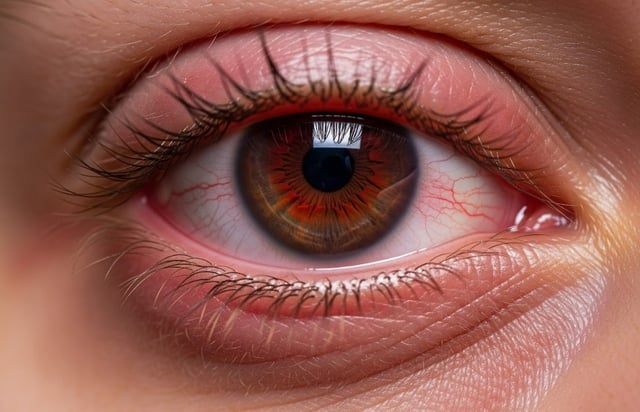The kidneys, which are responsible for filtering blood and maintaining fluid balance in the body, are closely linked to the circulatory system, including the delicate blood vessels that support the eyes. When kidney function begins to decline, it can cause a series of changes that affect vision, eye moisture, and even the way people perceive color, according to Times Entertainment (India).
Here are three common eye-related symptoms that could indicate underlying kidney problems that people should be aware of.

Persistent puffy eyes, especially the eyelids, can be a sign of kidney damage.
ILLUSTRATION: AI
Prolonged puffy eyes
It's normal to wake up with slightly puffy or swollen eyes after a late night or a salty meal. However, if your eyes remain puffy throughout the day, especially around the eyelids, it could be a sign of proteinuria—a condition in which protein leaks into the urine due to kidney damage. This loss of protein causes fluid to build up in soft tissues, such as around the eyes.
Swelling of the eyes or other parts due to kidney problems is often persistent, and may be accompanied by other symptoms such as foamy or bubbly urine. If you notice these signs, do not ignore them and see a doctor for a urine test and kidney function test as soon as possible.
Blurred vision or “double vision”
Sudden vision changes such as blurred vision, difficulty focusing, or double vision (seeing two things at once) can be caused by problems with the small blood vessels in the eye. This condition, called retinopathy, is often caused by a variety of conditions, including high blood pressure or diabetes. Both of these conditions, if not well controlled, are leading causes of chronic kidney disease (CKD), which can damage the blood vessels in the retina.
This damage can lead to fluid leakage, swelling of the retina, or, in severe cases, vision loss. If you have high blood pressure or diabetes and experience frequent vision problems, monitoring your kidney function along with regular eye exams is essential.
Difficulty recognizing some colors
Some people with kidney failure may have difficulty perceiving colors, especially blues and yellows. This is likely due to damage to the optic nerve or changes in the retina – a result of long-term high blood pressure, diabetes or urea toxins (waste products that build up in the body due to poor kidney filtration).
Eye abnormalities are often difficult to detect at first, but may progress without obvious kidney-related symptoms. In some cases, these problems may mimic common eye conditions, delaying timely and accurate diagnosis. If left untreated, they can worsen, signaling more serious systemic health problems.
If you notice any unusual or persistent changes in your eyes, especially if they are accompanied by other symptoms such as fatigue or swelling, seek medical attention right away. Early detection is key to controlling kidney disease and protecting your long-term health, including your vision.
Source: https://thanhnien.vn/3-bieu-hien-o-mat-canh-bao-van-de-ve-than-185250816160040349.htm





![[Photo] Prime Minister Pham Minh Chinh receives President of Cuba's Latin American News Agency](/_next/image?url=https%3A%2F%2Fvphoto.vietnam.vn%2Fthumb%2F1200x675%2Fvietnam%2Fresource%2FIMAGE%2F2025%2F12%2F01%2F1764569497815_dsc-2890-jpg.webp&w=3840&q=75)



































































































Comment (0)